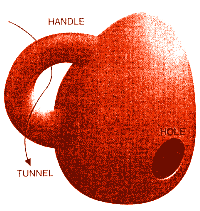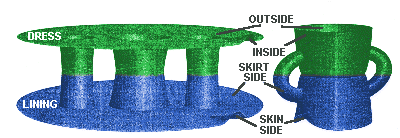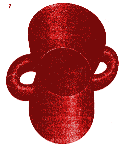

by Ian Stewart
The Topological Dressmaker
The floor was littered with bits of paper pattern, pins and snippets
of cloth. Jemima Duddlepuck whistled as she worked on her new summer dress,
while in a corner her dog, Pucci - who was rather lazy and very fat-snored
happily. It was the first time Jemima had ever tried to make a dress with
a lining. All that remained was to sew the two together, so that the seams
ended up inside, between lining and dress, invisible from the outside.
She looked at the instructions. "Turn the lining inside out. Slip it
over the dress. Machine around the neck and armholes. Turn the completed
dress the right side out." Ever so gingerly, she machined around the armholes
and the neck. The hems, of course, were left unattached. Done! Oh, it was
going to be really nice. Jemima began to turn it inside out.
Funny. Was something stuck? No, if she turned it hack to the start,
then everything seemed okay. But that final twist eluded her. Half an hour
later she hurled the balled-up wad of material into the corner of the room
and burst into tears. All that work for nothing.Then, having vented her
frustration, she sat down to think the matter through. Jemima believed in
learning from mistakes.
Had she made some parts the wrong shape? No, that wasn't likely. If
you couldn't turn a slightly distorted dress inside out, then you couldn't
turn a perfectly made one inside out either. Whether or not you could turn
something inside out was a topological question-the answer didn't change
if the object was continuously deformed. That meant two things. First, there
was something wrong with the instructions in the pattern book-because whatever
mistakes she'd made, they had to be very small ones. Second, there had to
be a topological reason why the instructions were wrong.
What could she remember about topology? Well, there was the idea of
topological equivalence. Two objects are "the same," or topologically equivalent,
if one can be deformed continuously into the other. You can bend them and
stretch them and shrink them and twist them, but you cannot cut them or tear
them or glue bits together that weren't glued together to begin with. That
was the basic idea-but what kind of things did topologists study? There was
a lot of stuff about Klein
bottles and
Möbius strips, surfaces with only
one side. But that wasn't likely to be relevant to problems about things
with two sides. Then there was some other stuff about surfaces with holes.
That was more likely to be useful.
She recalled that "hole" is a rather ambiguous word in topology. For
instance, people usually say that a donut - or torus - has a hole in it.
But the hole isn't really in the donut at all. It's just a place where the
donut isn't. Whereas if you take a car inner tube-also a torus - and cut
out a patch of rubber, then you really do get a hole.
 |
Some topological terminology |
All right, she thought, I'll call the kind of hole you cut out with
scissors a hole, and the kind where the surface just isn't I'll call a tunnel.
One way to create a tunnel is to add a handle to a simpler surface [see
illustration left]. By adding handles one at a time to a sphere, you first
get a torus, with one tunnel through the middle. And then there's the two-
handled torus, the three-handled torus and so on. She knew these were often
called the two-holed torus and so on, but she wasn't keen to use the "hole"
terminology without being very careful indeed what she meant.
Now, the instructions were to turn the lining inside out, so that
its outside was on the inside; machine the neck and armholes; and then turn
both lining and dress inside out so that the inside of the lining was next
to the inside of the dress-no, the outside of the inside of the... no, the
inside-out lin-. Oh, heck. Terminology for sides was going to be at least
as much a problem as terminology for holes.
Start again. The dress has two sides: the outside, which is what everyone
sees when you wear it, and the inside, which is what they don't see. The
lining also has an inside and outside, but those are confusing words. So
call the side of the lining that fits next to the skin the skin- side and
the other side of it the skirt- side because it goes next to the dress. Well,
as mnemonics go, those weren't too bad. It reminded her of George A. Strong's
parody of Hiawatha :
When he killed the Mudjokivis,
Of the skin he made him mittens,
Made them with the fur side inside,
Made them with the skin side outside,
He, to get the warm side inside,
Put the inside skin side outside.
So the sides of the material, reading outward, have to end up in this
order: skinside, skirtside, inside, outside And they had to be machined so
that the stitches around the armholes and the neck were hidden between skirt-
side and inside.
Topologically, both the dress and lining were equivalent to disks
with three holes. The rim of each disk was the hem, and the holes were the
two armholes and the neckhole. What the pattern book said was to place the
disks so that the skinside was next to the outside; machine all three holes
so that the stitches were on the skirtside/inside surfaces [see left illustration
below] and then turn the whole ensemble inside out.
So the question was, what happened? Well, she thought, you can deform
the whole ensemble topologically until it becomes a two-handled torus with
two holes cut in it. (To see why, imagine sliding both ends of the two armhole
tubes onto the neckhole tube and then bending the dress hem up and the lining
hem down and shrinking them [see right illustration below].) So the problem
becomes: Can you turn a two-handled torus inside out if there are two holes
in it?
 |
| DRESS PLUS LINING is topologically equivalent to two disks, each with three holes, sewn together along three edges (left). This configuration in turn is topologically equivalent to a two- handled torus with two holes, hems of dress and lining (right). |
It was kind of hard to think about, so Jemima started with something
simpler.
Can you turn an ordinary torus inside out when one hole is cut in it? And
the answer, of course, was yes. The idea was to flip the entire thing through
the hole, but then the handle was like a tunnel bored into a sphere rather
than a handle stuck on the outside. But you could imagine sticking a finger
into the tunnel and straightening it. Then the part of the surface "outside"
the tunnel is a rather distorted handle, which can be tidied up to look like
a neater one. Then you got something that looked just like a torus again
[see illustration below].
 |
| How to turn a torus inside out through one hole |
So topologically, there was no difficulty.
She realized she could play the same game on the two-handled torus, too.
She sketched a series of pictures of the process. First, turn the whole thing
inside out through its holes, rather like reversing a sock (or in this case
an ankle warmer because of the two holes). Then the two handles on the outside
became two tunnels on the inside [see illustration below]. But then you can
stick your finger into each in turn and pull it out to create a handle on
the outside. And then all you have to do is twist each handle around, and
you end up with the original ensemble, but turned inside out.
Hmm. You could do it topologically, then. Strange, because
when she tried it with an actual dress, it didn't work.
Why not? Dresses, unlike topological spaces, can't be stretched or shrunk.
They can be crumpled up and twisted around, though. It was possible that
the material nature of the dress changed the answer, but she had a feeling
that something both simpler and more fundamental was involved. She picked
up the ruined mess from where she had flung it and smoothed it out. She could
wriggle her arm between the various surfaces, and it really did seem as if
there were three handles. But near the armholes and neckhole everything was
confused, as if the lining and the dress were getting mixed up. There were
three handles, all right, but they just weren't in the right places.
 |
| TO TURN the ensemble inside out, reverse the whole thing.
Pull the tunnels out to form handles. Twist the handles into correct position.
Note, however, where seams end up. |
Aha! She'd forgotten to think about the seams. They had to end up in
the right places, neatly separating dress from lining. But did they?
She drew the seams on her pictures. No, they didn't. When the surface was
stretched, to create the handles from the tunnels, and then twisted to put
the handles in the right place, all three seams ended up in completely the
wrong places. (E. C. Zeeman of the University of Oxford has proved that there
is no way to make them end up in the right places.) So that was the
topological obstruction to turning the ensemble inside out. You couldn't
do it if the seams had to end up where they started.
And that gave her another idea. Maybe the ensemble wasn't ruined after
all. She could unpick the stitches and try to find some other method of making
the seams. She would be on her own, though - obviously, the instructions
on the pattern were crazy.
Jemima unpicked one armhole, then the other. She was about to start on the
neck when she had another thought. Topologically, each hole was just as good
as the others. You had to start by machining some seam. The neck was
as good a place to start as any.
Let's experiment, she mused. She pulled the lining inside the dress, skin-
side inside, then skirtside next to inside of dress, then the outside of
the dress- well, outside.
Great! She even found that she could poke the arms of the lining down
the arms of the dress, just where they ought to end up. The only trouble
was, she couldn't machine around the seam; the stitches would be on the
outside.
So turn just the arm inside out. She pulled the arm of the lining inside
the dress, turning it inside out like a sock. Then she did the same with
the arm of the dress. She burrowed into the ensemble from the hem end, flashlight
in hand. It certainly looked as if the arm could be restored to its correct
position. All she had to do was push the sewing machine up inside the ensemble
and then-
Stupid. Sheepishly, she backed out of the heap of crumpled cloth. She reached
in through the neck and pulled the sleeve out into the open. She ran the
seam through the machine, then turned it inside out and back to its proper
position. Now the dress really was finished. She tried it on and pirouetted
in front of the mirror. Brilliant!
I ought to write a book about this, she reflected. Topology for
Tailors. I could throw in all the party tricks, like taking off your
vest without removing your jacket.
By now her mind was in overdrive. Suppose you were a Martian with 17 arms.
How many hems would be needed to make a Martian ensemble, dress plus lining?
Seventeen? No, just two. Use the same trick of machining the neck only and
then dealing with each arm in turn by pulling it through the neckhole, inside
out. Unfortunately, there weren't any Martians. So she wouldn't get to try
it out-"Pucci, stop that, your nose is all wet!" She pushed the little dog
gently away.
Say, Pucci had four "arms," and its tail could poke out through the
hems. Jemima took the dog's measurements, tut-tutting at the figures for
the waist- line. She cut shapes from remnants of the cloth, whistled, sewed,
twisted and turned. Yes, even with four "arm" holes, the method worked fine.
Now to see if the dress fitted the dog.
It fitted, in the sense that the measurements were okay. But fat dog
into small hole won't go.
In the real world, there are nontopological constraints.
| Chaos | Quantum | Logic | Cosmos | Conscious | Belief | Elect. | Art | Chem. | Maths |
SCIENTIFIC AMERICAN July 1993 File Info: Created 2/5/2001 Updated 17/10/2000 Page Address: http://www.fortunecity.com/emachines/e11/86/klein2.html